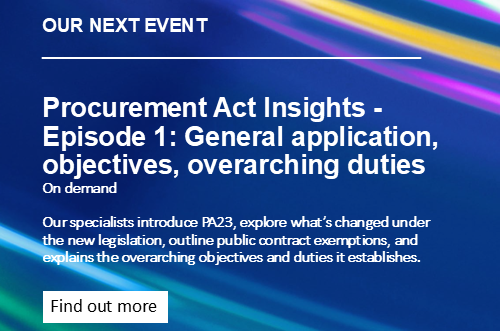- Details
ASA ruling on Wahed Invest Ltd: a critical analysis
George McLellan and Fred Groves provide insight into the recent ASA ruling on poster advertisements on Transport for London locations for an online Islamic investment company.
On 8 January, 2025, the Advertising Standards Authority (ASA) issued a ruling regarding a series of poster advertisements for Wahed Invest Ltd (Wahed), an online Islamic investment company (ASA Complaint Ref: G24-1262171).
These ads were displayed in Transport for London (TfL) locations, including on TfL trains, London Underground platforms and TfL busses, and drew significant regulatory scrutiny.
An example of one of the ads is displayed in an online BBC article titled ‘Ads showing banknotes on fire banned by regulator’.
Referring to the UK Code of Non-broadcast Advertising and Direct & Promotional Marketing (CAP Code), the ASA determined that the ads “were likely to cause serious offence” and mandated that they “must not appear again in the forms complained of.”
Having considered the ASA ruling, we believe this decision raises interesting and important questions about regulatory limits on taste, offence, and freedom of commercial expression.
In particular, in the context of Wahed’s Islamic principles and its Article 10 right to freedom of commercial expression under the European Convention on Human Rights (ECHR).
Background and ASA Ruling
The ASA’s Role
The ASA is a non-statutory organization funded by a levy on advertisers in the UK. Its website outlines its functions as ensuring compliance with advertising rules and responding to complaints to ban ads deemed “misleading, harmful, offensive, or irresponsible.”
The ASA’s website page, ‘How we handle complaints’ states:
“We take all complaints seriously, but we look at whether or not the rules have been broken rather than simply basing our decisions on the number of complaints an ad might prompt.”
This context is relevant in assessing whether the ASA adequately considered the nature of the complaints against Wahed’s ads, and whether the offence allegedly occasioned by the ad campaign reasonably outweighs the advertiser’s right to commercial freedom of expression.
Wahed Invest Ltd
Wahed, a digital investment platform, promotes financial services structured in adherence to Islamic principles.
Its marketing emphasises ethical and Shariah-compliant investment opportunities, including the prohibition of interest (Riba). The company’s ads included slogans such as:
“Charging people to borrow money was once called exploitation. Sadly, that perception has changed and now interest has caused a massive wealth gap, enriching the few while the majority get poorer. Join the growing community moving their money to a fairer system, one that serves you! Download Wahed now. Join the Money Revolution.”
The Wahed ads and the complaints
The ASA ruling focused heavily on the depiction of burning US dollar and Euro banknotes in the Wahed ads.
This imagery was deemed by the ASA as being likely to cause “serious offence” to individuals from the United States or Eurozone countries, on the basis that these currencies are considered culturally significant and symbolic of national identity.
The ruling also highlighted that seventy-five complaints were received by the ASA in relation to the ads.
The CAP Code and ASA Guidance
Rule 4.1 of the CAP Code states:
“Marketing communications must not contain anything that is likely to cause serious or widespread offence. Particular care must be taken to avoid causing offence on the grounds of: age; disability; gender; gender reassignment; marriage and civil partnership; pregnancy and maternity; race; religion or belief; sex; and sexual orientation. Compliance will be judged on the context, medium, audience, product and prevailing standards.”
“Marketing communications may be distasteful without necessarily breaching this rule. Marketers are urged to consider public sensitivities before using potentially offensive material.”
“The fact that a product is offensive to some people is not grounds for finding a marketing communication in breach of the Code.”
This provision underscores the need to assess public sensitivities while allowing for some level of creative freedom in advertising.
Critical Analysis
A misjudged offence
While the ASA attributed offence primarily to the depiction of burning currency, it appears to have overlooked the interplay between this imagery and the Islamic themes which featured prominently in the ads.
As summarised in the ruling, Wahed explained that its depiction of burning money was a deliberate and principled critique of interest-based financial systems, which it argued is central to its Islamic ethos, explaining:
“They said the burning of banknotes within their ads was designed to be a powerful visual illustration that money stored in a way that was growing at a rate lower than inflation created a decrease in value and purchasing power in real terms. The purpose of the ads was therefore to show that, when inflation grew faster than the rate of savings, money was akin to ‘going up in flames’. They believed all viewers, including those who were not Muslim, would have understood that expression. They said the ads had not criticised specific groups and that they used US dollar and Euro banknotes because they were amongst the most recognised currencies in the world. The purpose of the ads was to promote ethical investing as defined by Islamic law.”
This coherent messaging aligns with the financial services Wahed promotes, and the ASA’s failure to appreciate this context undermines the ruling’s credibility.
Comparisons to other campaigns
“Burning money” is a popular and commonplace expression for waste, and its depiction would not ordinarily cause offence to reasonable people.
In fact, Wahed highlighted instances where burning money featured in advertising and media without eliciting similar backlash.
While not considered in the ruling, this inconsistency could raise questions about whether the complaints stemmed from the Islamic associations in Wahed’s campaign, rather than the imagery of burning money itself.
In the absence of the Islamic theme, it is plausible that the offence would not have been as readily drawn.
Balancing commercial freedom and religious convictions
Wahed’s ads reflect its religious convictions and need to be considered through the lens of commercial freedom of expression, each of these factors being protected under the ECHR.
By prohibiting the ads, the ASA risks disproportionately restricting Wahed’s ability to communicate its unique value proposition to its target audience, to defend public sensitivities where it is plausible that these sensitivities are motivated by unease about broader Islamic themes in advertising.
Striking a fair balance requires the ASA to consider the broader context of Wahed’s messaging and its alignment with religious and ethical principles.
Flaws in the ASA’s process
The ASA’s process also merits scrutiny. The Wahed ruling indicates that TfL’s advertising partner had submitted the ads to the CAP Copy Advice team, which deemed them unlikely to raise issues under the CAP Code.
If the CAP Copy Advice team found the ads acceptable, why did the ASA’s subsequent ruling diverge so fundamentally?
This discrepancy highlights potential inconsistencies in regulatory oversight that undermine advertiser confidence in the CAP’s copy advice guidance.
Moreover, the ASA did not disclose the substantive content of the seventy-five complaints it received.
Without transparency regarding the nature of these complaints – especially in circumstances where some of those complaints may have been primarily or entirely triggered by unease about Islamic themes – it is difficult to ascertain whether the offence was reasonably held.
Bias in complaints and robust ASA protections
The ASA’s decision demonstrates an insufficiently robust approach to balancing freedom of expression against complaints on the basis of offence, such complaint potentially being informed by bias or a lack of objectivity.
To be commercially effective, advertisers often need to make bold and provocative statements. In this case, the offended reactions seem unreasonable, especially given Wahed’s coherent justification for the imagery, and the fact of similar imagery having not triggered controversy.
Regulatory bodies must ensure they are not unduly swayed by subjective complaints rooted in cultural or religious bias, and must place a higher importance on freedom of expression and other ECHR rights in exercising their judgement.
Conclusion
In an era of diverse audiences and globalized messaging, regulatory bodies must exercise nuanced judgment.
The ASA’s decision, in this case, falls short of this standard, failing to adequately weigh Wahed’s lawful expression of its religious convictions against the alleged offence caused to a subset of viewers.
Ultimately, the offended parties’ reactions appear unreasonable, and the ASA’s ruling represents a missed opportunity to foster a more inclusive and balanced approach to advertising regulation.
George Mclellan is a Partner and Fred Groves is an Associate at Sharpe Pritchard LLP.
If you would like any advice or assistance in relation to the issues raised in this article, please contact us today by telephone or email
For further insight and resources on local government legal issues from Sharpe Pritchard, please visit the SharpeEdge page by clicking on the banner below.
This article is for general awareness only and does not constitute legal or professional advice. The law may have changed since this page was first published. If you would like further advice and assistance in relation to any issue raised in this article, please contact us by telephone or email
|
Click here to view our archived articles or search below.
|
|
ABOUT SHARPE PRITCHARD
We are a national firm of public law specialists, serving local authorities, other public sector organisations and registered social landlords, as well as commercial clients and the third sector. Our team advises on a wide range of public law matters, spanning electoral law, procurement, construction, infrastructure, data protection and information law, planning and dispute resolution, to name a few key specialisms. All public sector organisations have a route to instruct us through the various frameworks we are appointed to. To find out more about our services, please click here.
|
|
OUR RECENT ARTICLES
December 10, 2025
Sharpe Pritchard appointed to £60m London Boroughs’ Legal Alliance frameworkSharpe Pritchard, one of the UK’s leading public law firms, has been re-appointed to the London Boroughs’ Legal Alliance (LBLA) Solicitors Panel.
November 20, 2025
Strengthening the standards and conduct framework for local authorities in EnglandJames Berry offers his insight into how the proposed changes to standards and conduct rules will affect local authorities.
November 04, 2025
Procuring and operating open frameworks under the Procurement Act 2023Chantelle Pink offers advice to authorities on open frameworks and how to procure them.
October 31, 2025
Building Solar – 5 Top Tips for Solar Farm Construction ContractsSolar farm construction contracts are in focus following fascinating insights into the continuing global uptake and expansion of renewables, and particularly solar, within the 2025 mid-year report of Ember, a global energy think tank.
|
|
OUR KEY LOCAL GOVERNMENT CONTACTS
|
||
|
Partner 020 7406 4600 Find out more |
||
|
Partner 020 7406 4600 Find out more |
||
|
Rachel Murray-Smith Partner 020 7406 4600 Find out more |







 Catherine Newman
Catherine Newman
